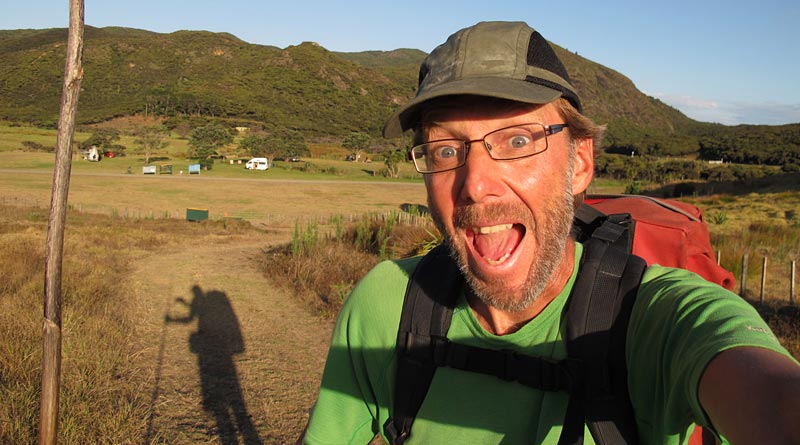Te Paki: New Zealand’s top hike
Does Northland need a Great Walk? Backers of a well-promoted, multi-day tramp in the North say it would boost tourism and open up opportunities for locals, but right now the country’s northernmost Great Walk is at Lake Waikaremoana — more than 800km south of Cape Reinga. I decided to check out Northland’s best candidate for Great Walk status, the three-to-four day Te Paki Coastal Trail.
The mosquitoes up there are as big as sparrows, they told me. And they come in swarms so big they blot out the sky, they added.
It turned out the dire warnings about the mosquitoes that guard the very northern tip of New Zealand were only half true: They are normal size but there are an awful lot of them.
I know this because my new tent, far from being insect-proof as claimed by its manufacturers, turned out to be a cunningly designed mosquito trap. But more about that later.

New Zealand has nine tracks classed as Great Walks by the Department of Conservation (DOC). They include some of the country’s best-known tramps — such as the Milford Track and the Tongariro Northern Circuit, which includes the hugely popular Tongariro Crossing — but they don’t necessarily have more spectacular scenery than tramps without the Great Walk label.
What they do have is a guarantee of well-formed and well-marked trails, bridges spanning any tricky river crossings, and comfortable huts a modest day’s walking apart.
They are also heavily marketed and relatively expensive to walk. Most need to be booked in advance. None are further north than Lake Waikaremoana in Te Urewera National Park.
Every few years calls resurface for a Great Walk in Northland. Having a trail in the same category as the Milford Track would boost the region’s profile and lure nature-loving tourists, but where would you put it?

Waipoua has the country’s largest remaining kauri forest but no established multi-day trail; Cape Brett is spectacular but the walk to the lighthouse only takes a day, then you have to retrace your steps or catch a boat out.
That leaves Te Paki Coastal Trail, a three- to four-day walk around the very northern tip of New Zealand. I decided to put it to the test.
One problem with the trail is that it isn’t a loop. And, unfortunately, outside the summer peak you can’t leave your car at one end and be confident it’ll still be there when you finish.
I decided to park at Waitiki Landing, a holiday park about 20km south of Cape Reinga, and see if hitch-hiking in Northland was as good as I remembered from my youth.
I’d walked about five paces and hadn’t even put my thumb out when a battered sedan screeched to a halt. Inside was Florian, a charming young Swiss traveller driving what looked like a mobile rubbish dump.
When he heard I wanted to go to Te Paki Stream he changed his mind about heading to the Cape and dropped me off at the trailhead instead. Easiest hitch-hiking ever.
I left Florian to scramble up New Zealand’s highest sand dune while I set off down the stream, weighed down by several days’ food and a new tent.
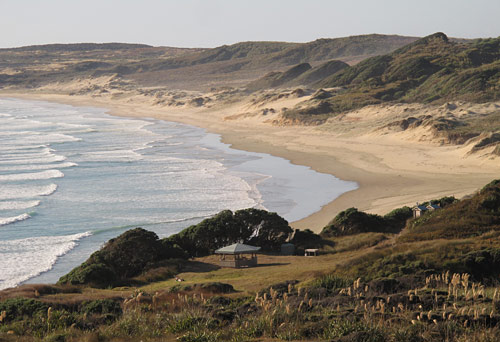
Te Paki Stream doubles as the northernmost vehicle access to Ninety Mile Beach so at times you have to dodge a procession of tourist buses. I had it to myself.
The stream skirts a series of golden, Sahara-like dunes before emptying into the Tasman Sea. From there it’s about an hour’s walk to Scott Point at the top of Ninety Mile Beach, where the track climbs a steep wooden staircase to a strange plateau of sun-baked clay and stunted manuka.
After another sweltering hour the trail descends to the evocatively named Twilight Beach, where there are no four-wheel-drives to ruin the ambience, just an empty expanse of sand, shorebirds, and dunes shrouded in salt spray.
At its southern end DOC has set up a campground as lovely as any you’ll find, with toilets, a water supply, a cooking shelter and space for a few tents overlooking the sea.
I didn’t quite have the beach to myself. Arnie, a German giant planning to walk to Ahipara, had set up camp already. His only food seemed to be a box of couscous. He claimed not to be hungry but hoovered up my leftovers like a starving man.
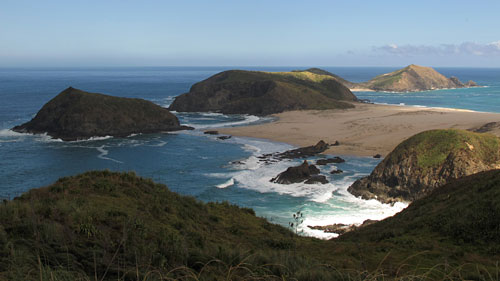
After watching the sun sink into the sea I made the first of many unpleasant discoveries about my tent. Two plastic panels pretending to be windows had ripped, providing a perfect entry for mosquitoes. I sacrificed half my supply of plasters to patch the holes, only to find the tent was cleverly designed to let in insects in two other places as well.
I resolved to demand a refund until I remembered I’d bought the tent in a closing-down sale. I spent most of the night squashing mosquitoes into bloody splotches.
The climb at the other end of Twilight Beach the next morning brought me to another plateau, this one with a Mars-like landscape of bare apricot-coloured earth unlike anything I’ve seen in New Zealand.
It also offered spectacular views of Cape Maria van Diemen, named by the Dutch explorer Abel Tasman in an early kind of naming rights deal honouring his patron’s wife. It’s a dramatic sight with a series of rocky outcrops linked to the mainland by a wind-swept sandspit, ending in a bleak, scrubby island crowned by an abandoned lighthouse.
The 90-minute detour to the cape brought more great views as far as the Three Kings Islands silhouetted on the horizon, and crossed dunes littered with thousands of empty, sun-bleached flax snail shells. Now rare, the pupu harakeke must have been incredibly common in the not-too-distant past.
From there the trail descended to Te Werahi Beach, bringing a first glimpse of Cape Reinga and another long trudge across the sand, then a steep climb up a sun-baked ridge to the lighthouse.
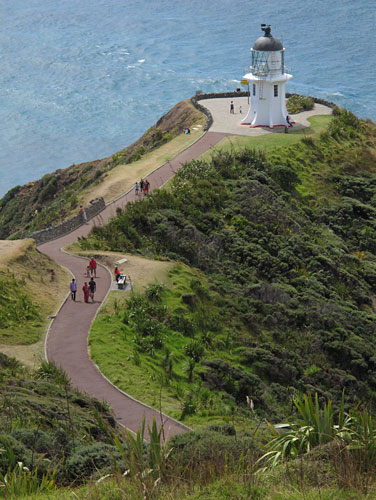
For all the beauty and significance of Cape Reinga or Te Rerenga Wairua, “the jumping-off place of the spirits” in Maori tradition, returning to civilisation was a shock.
After half an hour of screeching children and buffoons unable to read the “no dogs” signs, put there to protect wildlife, I was relieved to pick up the track again.
From the lighthouse the trail drops steeply to stunning Sandy Bay, where, according to the signs, whales occasionally swim right into the bay and use the rocks to scrape barnacles off their bellies.
I had encrustations of my own to wash off after two sweltering days of tramping without a shower. My skinny dip at Sandy Bay stripped away the sweat and fatigue and was fantastically refreshing. I apologise, however, to the passing day-tripper I probably traumatised.
I was tempted to stay the night but pressed on instead. Another steep climb was rewarded with extraordinary views of the sun sparkling off water and a series of headlands reaching back to Te Rerenga Wairua as the trail followed the clifftops to Tapotupotu, a DOC campground at the water’s edge.
Tapotupotu, which can be accessed by road, was also busy but the tourists there were a different breed. I passed a pleasant evening talking to young Germans and Swedes excited to be camping amid such scenery.
Then darkness fell and my tent developed another split. The night was torture with brief snatches of sleep punctuated by frenzies of slapping and squashing.
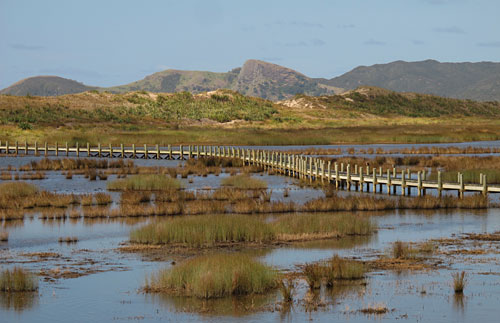
Dawn was a relief. I waved goodbye to my new friends and picked up the trail again, first on a boardwalk beside a stream, then over a series of steep hills.
The last day was something of a tired, blistered blur. I recall the track swinging inland and traversing a sharp ridge with only bonsai-sized mānuka for shade during frequent rests.
Somewhere I literally bumped into the only other person I met on the trail, a young Englishman with the most extraordinary ginger sideburns I’ve seen. I also remember the blissful shade of the first real bush on the trail, a boardwalk curving hundreds of metres across a vast tidal lagoon, and a last, energy-sapping trudge through soft silica sand to Spirits Bay.
I was very pleased to reach the campground. I didn’t even notice the mozzies.
· · · · ·
So could the Te Paki Coastal Trail qualify as a Great Walk? It ticks the boxes for duration (three to four days), track quality, terrain (mostly easy with no dodgy river crossings), scenery (spectacular) and uniqueness (rare plant species and landscapes like the giant dunes at Te Paki). And none of the existing Great Walks can match Te Rerenga Wairua for spiritual significance.
All Te Paki lacks is a series of serviced huts spaced a day’s walk apart. However, with swingeing cuts to DOC’s budget under the National-led government of 2009-17, which have seen the department slash jobs and rely increasingly on sponsorship and volunteers, it’s unlikely a chain of huts will be built in Northland anytime soon.
Whether or not it’s ever officially declared a Great Walk, Te Paki Coastal Trail is most definitely a great walk. Pack your hiking boots, a tent, a bit of food and some insect repellent, and enjoy. And do it before the rest of the world finds out.
Te Paki practicalities
WARNING: Check the status of Te Paki Coastal Trail with the Department of Conservation or Far North iwi Ngāti Kuri before setting out on your walk. Parts of the track were still officially closed in early 2024 due to damage from Cyclone Gabrielle in February 2023 and a wildfire near Twilight Beach in March 2023. While the track may still be passable, campgrounds and water supplies may not be maintained or available.
The Te Paki Coastal Trail takes three to four days from either Te Paki Stream or Spirits Bay.
It matters little which direction you walk it. You can shorten the trail by starting or finishing at Cape Reinga or the Department of Conservation campground at Tapotupotu; if you start at Spirits Bay you could carry on walking down Ninety Mile Beach for another three days until you reach Ahipara.
There are no huts so you need to carry a tent as well as your food, a cooker and other essentials.
If you want any sleep your tent should be mosquito proof. You may also want to bring insect repellent. There is little shade so you’ll need a sunhat and sunblock.
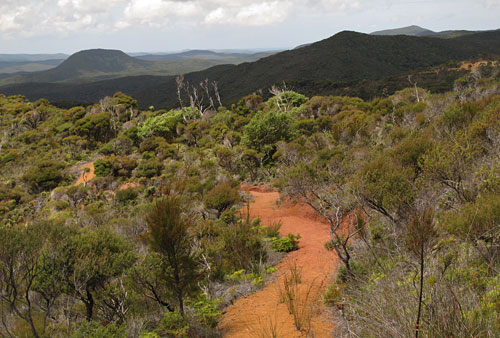
You can camp anywhere along the route (except at Cape Reinga) but your choice of campsite will depend on the availability of water. Bore water is on tap at Spirits Bay/Kapowairua and Tapotupotu campgrounds, as well as the “micro-campings” at Twilight Bay and Pandora. There’s also a drinking fountain at Cape Reinga. In summer you’ll find very little fresh water between those points so a good-sized bottle is a must.
In the Christmas-New Year period you can leave your car at Spirits Bay and ask the camp warden to keep an eye on it. At other times the campground is unattended. The safest option then is to leave your car at Waitiki Landing Holiday Park for $5 a night; from there you can hitch-hike to your starting point or the friendly ladies can arrange a shuttle.
It costs $80 to have a group dropped off at one end and picked up at the other a few days later. The catch is, with no cellphone coverage in the area, you can’t change the pickup time.
Camping at Spirits Bay/Kapowairua and Tapotupotu costs $6 per person per night. The Twilight and Pandora campgrounds are free. Tapotupotu and Twilight in particular are beautifully located.
Note that the details given here were current in 2015. Costs may have changed since then.

